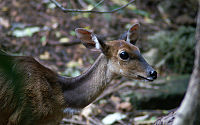
Bushbuck
Background to the schools Wikipedia
SOS Children volunteers helped choose articles and made other curriculum material Before you decide about sponsoring a child, why not learn about different sponsorship charities first?
| Bushbuck | |
|---|---|
 |
|
| Conservation status | |
|
Least Concern |
|
| Scientific classification | |
| Kingdom: | Animalia |
| Phylum: | Chordata |
| Class: | Mammalia |
| Order: | Artiodactyla |
| Family: | Bovidae |
| Subfamily: | Bovinae |
| Genus: | Tragelaphus |
| Species: | T. scriptus |
| Binomial name | |
| Tragelaphus scriptus ( Pallas, 1766) |
|
The Bushbuck (Tragelaphus scriptus) is an antelope that is found in forest and woodland throughout Sub-Saharan Africa. Also called "bush antelope", this is used occasionally for any relativers with which it shares its habitat.
Description
Bushbuck live in habitat including rain forests, montane forests, forest-savanna mosaics and bush savannas. Bushbuck stand about 90 centimetres at the shoulder and weigh from 30 to 80 kilograms (depending on sex). Bushbuck have a light brown coat, with up to seven white stripes and white splotches on the sides. The white patches are usually geometrically shaped and on the most mobile parts of their body such as the ears, chin, tail, legs and neck. The muzzle is also white and horns are found only on the males and they can reach over half a metre with only one twist. At 10 months old, young males sprout horns that are particularly twisted and at maturity form the first loop of a spiral.
Bushbuck eat mainly browse but supplement their diet with any other plant matter they can reach. Bushbuck are active around 24 hours a day but tend to be nocturnal near human habitations. Bushbuck tend to be solitary, though some live in pairs.
All bushbucks live within a "home" area they will not normally leave this area, which is usually around 50,000 square metres on the savannah and much larger in the forest. These areas usually overlap other bushbuck home areas. Bushbucks are basically solitary animals and the mature males go out of their way to stay away from each other. Usually bushbuck are most active during early morning and part of the night, therefore are almost entirely nocturnal in areas where they are unlikely to be disturbed.

